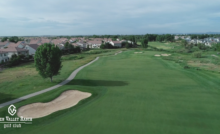Going Native
In the winter of 2008, we started the process of obtaining Audubon Cooperative Sanctuary Certification for The Valley Club in Hailey, Idaho. The Audubon Cooperative Sanctuary program for golf courses is an award-winning education and certification program that helps golf courses protect our environment and preserve the natural heritage of the game of golf. Although it was an arduous feat, when we received the call from Audubon acknowledging that we had been approved, we were overjoyed. We became only the fourth golf course in the state of Idaho, and one of 838 in the world to be certified, so it was a great honor for our club.
The certification process is not one to be taken lightly. There is a lot of information to be compiled, including the amount of acreages of mowed and un-mowed turf, a list of wildlife, fertilizer and pesticide records for past years, photos, drawing maps, diagrams, and numerous other items pertaining to golf course management. After completing the 65-page application, we sent it in hoping we were finished. I received a call from Jim Sluiter, a staff ecologist for the Audubon Cooperative Sanctuary, who carefully explained the additional steps that were needed to finalize the certification. Thinking we had finished was as far from the truth as possible. There was a multitude of information that was still to be completed, and many other pictures that had to be taken. Many items were brought to our attention, such as fuel spill containment issues, wash rack drainage, and chemical filling containment. Most of these issues weren’t issues at all , but required further detail for clarity. So 18 months from when we first opened the application packet, we received confirmation that we had been approved by the Audubon Cooperative Sanctuary.
The Audubon Cooperative Sanctuary Certification is an ongoing process to continue their environmental standards. They like to be updated on new projects that impact a course’s certification. Soon we started looking for areas on the property that we could improve to help our efficiency as well as make a difference environmentally. One area that really caught our attention was turf that we were mowing that didn’t necessarily need to be cut. The areas could be grown up to native stands and only mowed once a year in the fall. We analyzed and dissected the course, looking at places that could be extended into the regular native stand and a new course began to emerge. Tee complexes that had 10 to 15 yards of mowed turf on each side could now be allowed to have native grasses growing up to 3 or 4 yards from an edge. This began to really frame in the tees. The tees have a sculpted look and now the native flows with the shape instead of a long boring line of native off to the side. Before we knew it, we were looking at adding more than an acre of native to our already large native stand of 50 acres. An acre isn’t that large of an area unless you look at it from a turf manager’s perspective. That acre may only take 10 minutes to mow, but three times a week multiplied by the six-month season could get a savings of up to 12 hours of mow times. That is a lot of time that can be spent on other projects. Designating these areas as native turf gives us numerous other benefits for our department as well.
Aside from our operation being a bit more efficient, we now have an even larger wildlife buffer. The native areas are important for much of the burrowing animal population that we have here: ground squirrels, voles, ferrets, martins, and mice just to name a few. Theses animals are then in turn beneficial to the predators on the course which include foxes, snakes, golden eagles, hawks and coyotes. Granted voles and ground squirrels aren’t desirable to have in a golf course because of their destructive nature, but they help keep the circle of life in balance. Having all of these animals on our property gives us a more diverse population.
We all strive to be the most efficient with our irrigation systems as we possibly can. In an area such as the high desert here in Idaho, water is a very touchy issue so any savings that you can have works for you tenfold on a larger scale. Water that used to hit these new native areas will be lessened or turned off completely. Some of the new native areas will receive water regardless, due to their close proximity to tees but most of it is around rough areas that can be controlled through our irrigation system manually. This is turn helps shorten our daily water window to irrigate more efficiently.
Another very interesting thing happened when we received our certification. We mentioned to our Head Golf Professional Jaime Sharp that they should get the Audubon logo applied to shirts and hats that could be sold in the golf shop. This had a snowball effect for our department as well as theirs. We are going to put the logo on all of our golf maintenance hats for next season. And as of the writing of this article, the golf shop is having the logo embroidered on golf shirts and hats for the membership to wear with pride.
In the process of filling out the application, taking photos, drawing diagrams, and creating maps, we really learned a lot about our property. If we wouldn’t have finished the certification we may not have ever really been able to see that these native areas could be added. Adding these native areas to our course won’t work for every other one, but every course definitely has the ability to improve itself in being more green (in our case brown) if they search for it. The Audubon Cooperative Sanctuary is a group that believes in the promotion of environmental quality, water quality and reduction and the existence of flourishing wildlife. Any course can improve on these items when they look at their entire operation. It takes time and effort but it is for the greater good of our industry and the environment as well.
Recent Posts
The Rare Condor: What It Means for Golf and the Course Maintenance Behind It
Imagine this: you're on a par-5, having just hit your second shot toward the green.…
DENIOS Under Bench Cabinet Provides Safe Storage of Lithium-Ion Batteries
DENIOS introduces asecos under bench cabinets for the safe storage of undamaged lithium-ion batteries. They…
True Blue Golf Club, One of America’s Top 100 Resort Courses, Acquires Steve Dresser Golf Academy
True Blue Golf Club has acquired the Steve Dresser Golf Academy, a renowned instructional facility…
Memphis Country Club: A Golfer’s Study in Precision and Tradition
If you have ever teed it up at Memphis Country Club, you know this isn’t…
Superintendents Online Turf Directory – EVERYTHING TURF
Our online directory, directory.GolfCourseTrades.com is the go-to resource for the busy superintendent. It is your opportunity…
Foley Company attains GCSAA Silver Partner Status
Foley Company, a leader in turf equipment innovation and technology, affirms its support of the…



